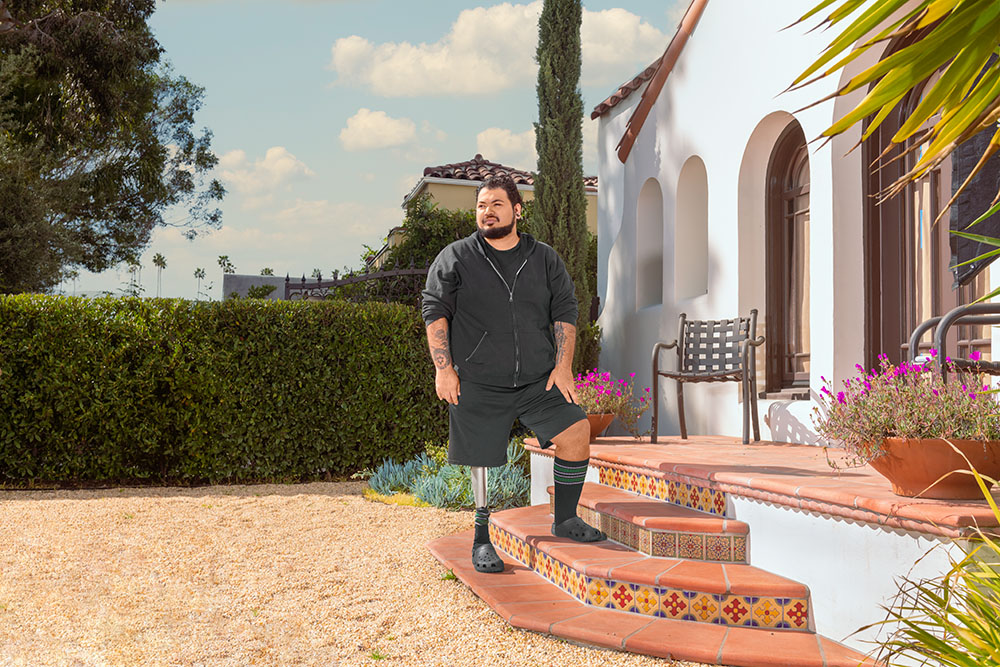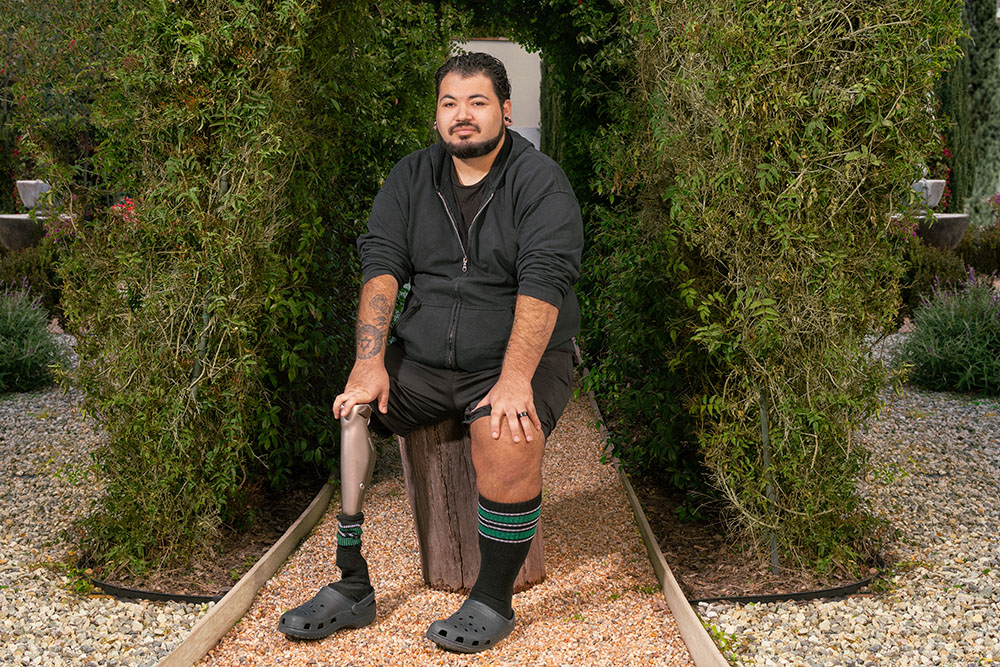
A prosthetic leg option from Europe delivers exceptional mobility. Keck Medicine of USC is one of only a few places in the United States to offer it.
For Robert Johnson, the ability to pick up his young daughter and go for walks around the neighborhood with his wife means everything. But it was not long ago that this simple activity posed a major challenge.
Robert had his right leg amputated above the knee in 2019 after a cancer diagnosis. He relied on a traditional prosthetic, a socket that fits atop the residual limb and connects to an artificial leg. But the Mid-City resident constantly felt off balance and afraid to hold his baby girl.
“When I had a socket on, it wouldn’t ‘stick’ on to me,” Robert says, “so I was always scared the leg would fall off and I would fall and drop her.”
Thanks to an innovative procedure offered at Keck Medicine of USC called osseointegration — where a metal implant inserted into the bone of the remaining limb is attached directly to a prosthesis — Robert has gained better mobility and the confidence to experience life with his family.
And the surgery, performed for more than two decades in Europe, now has the potential to help many other patients with prosthetic legs.
Preventing cancer spread through amputation
In 2016, Robert started to experience chronic pain in his right leg. A bump formed above his knee and continued to grow, but multiple physicians sent him away without a diagnosis.
“I went to different doctors and hospitals for about a year, and they all told me it was nothing,” Robert says. “At one hospital, they did an X-ray, decided it wasn’t cancerous, and just sent me home with pain medication.”
The turning point finally came after Robert was referred to Lawrence Menendez, MD, an orthopaedic oncologist with Keck Medicine. After performing a biopsy, he diagnosed Robert with osteosarcoma, an invasive form of bone cancer, and performed surgery to remove the mass from the patient’s leg.
To prevent the cancer from spreading further, Dr. Menendez and his team needed to amputate his right leg above the knee.

The news came while Robert’s wife was pregnant with their daughter.
“I just went for it because I didn’t want the worst outcome that could happen from cancer,” Robert says. “I was thinking long term, being able to be there for my daughter.”
After the wound healed and six months of chemotherapy, Robert was cancer-free and fitted with a socket prosthesis. But walking with it was challenging, and the onset of the COVID-19 pandemic kept him from regular physical therapy appointments.
Unhappy with his limitations, Robert began researching other options.
“I watched an interview with a woman who had been struggling to get around, but after the osseointegration procedure, she could walk and even go hiking,” he says. “I really wanted that.”
What is osseointegration? Procedure enhances stability and balance
The timing was ideal. The U.S. Food and Drug Administration had approved osseointegration for above-knee amputations in December 2020, and Dr. Menendez was one of just a handful of surgeons in the country with the training and expertise to perform it.
“Robert was a good candidate,” says Dr. Menendez. “He’s a young guy and otherwise healthy, and I thought he would benefit greatly from this type of prosthetic management.”
Osseointegration is a two-part procedure in which a metal implant is inserted into the bone of the residual limb after the amputation. Over the course of about three months, the bone grows into the implant until it is secure and fully integrated.
Being one of the first centers in the U.S. to perform osseointegration, we’ve established a solid track record here at Keck Medicine and we’re ahead of the game.
Lawrence Menendez, MD, orthopaedic oncologist, Keck Medicine of USC
Next, an additional device is attached to the implant, which protrudes from the skin and attaches to the prosthesis. Patients take up to a year to heal and require physical therapy.
The primary benefit of osseointegration is that it dramatically enhances the patient’s stability and balance.
“With osseointegration, the prosthesis is connected directly to the femur bone, so patients really feel like it’s just their leg,” Dr. Menendez says. “Patients are much more comfortable walking — especially walking uphill, downhill and even backward.”
Osseointegration in the U.S. offers ‘remarkable’ potential
Dr. Menendez performed the first surgery on Robert in March 2021. Robert says he relied on crutches to get around while he waited for the bone to grow into the implant. The second surgery took place three months later.
Robert started weight-bearing training about six weeks after that to learn to walk on the new prosthetic, with physical therapists gradually increasing the amount until he was comfortable placing his entire body weight on the prosthetic.
Today, the 28-year-old no longer worries about the leg coming loose.
“I just screw the prosthetic onto my leg, and it doesn’t come off,” he says. “I’m never scared to hold my daughter anymore.”
Osseointegration typically involves two surgeries, but Robert has a third scheduled due to the size of his thigh. A plastic surgeon will contour Robert’s thigh and remove extra tissue and muscle surrounding the implant.
His quality of life, meanwhile, is forever changed.
“When I put my prosthetic on the floor, I can feel the different sensations,” Robert says. “I can feel the grass, I can feel sand, I can feel soft surfaces. It feels completely different from having a socket.”
Robert’s journey is poised to be one of many stateside success stories, Dr. Menendez says.
“Being one of the first centers in the U.S. to perform osseointegration, we’ve established a solid track record here at Keck Medicine and we’re ahead of the game,” he says.
“It’s been remarkable to see what patients can do with this type of prosthetic management.”
Topics


